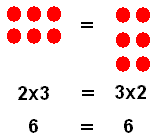Geometric Representation in Algebra
|
When we are working on a mathematics problem using algebra, it is often useful to use a
geometric representation. Sometimes we use dots
as in the following representation of the commutative property of multiplication over addition and subtraction.
 In this case, 2 dots represent the number 2, and 3 dots represent the number 3, with dots arranged in rows and columns representing multiplication. We also use lines to represent numbers. If the line has a length of 1, it represents the
number 1. If it has a length of 5, it represents the number 5. What number will the line represent if it has
a length of 1.5? After you have selected an answer, move the mouse over answer to see if you understood.
 As you can see, using lines to represent numbers has the advantage of representing numbers that are not integers. The lines in the manipulative to the left can be changed to represent different integers. Click on the point at the end of a line and drag it without letting up the mouse button. Notice that as the line changes length, the numbers at the top change too. Discussion question: Since the length of a line is typically taken to be positive, a number we represent with a line might also be considered positive. How could you represent a negative number using a line?
cont01 |
|
When we were using dots, we could represent addition by two groups of dots.
 In this example, we have 3 dots plus 5 dots, which clearly equals 8 dots. This represents the addition problem 3 + 5 = 8. We can also represent addition using two line segments that are part of the same line. The end point of one of the line segments is also the endpoint of the other. The length of both the lines together is the sum of the length of each line. Click on each of the points in the manipulative and drag them to see what happens to the lines and their sum.
cont02 |
|
Now we will consider geometric representations of multiplication. With dots we use
rectangles of dots to represent multiplication. The following figure represents
2·5 = 10.
 Similarly, in math, we can use lines at right angles to represent multiplication. In the figure on the left, the lines A and B are perpendicular and make right angles. The area of the rectangle created is equal to the product of the lengths of the sides. Click on the points and drag them to experiment with the manipulative.
cont03 |
Now we want to combine addition and multiplication to show the algebraic identity for the distributive property of multiplication over addition and subtraction, written algebraically as a(b + c) = ab + ac. Notice that we can group the figure on the left as a(b + c) or as ab + ac.
Click here for more on the distributive property of multiplication over addition and subtraction.
cont04